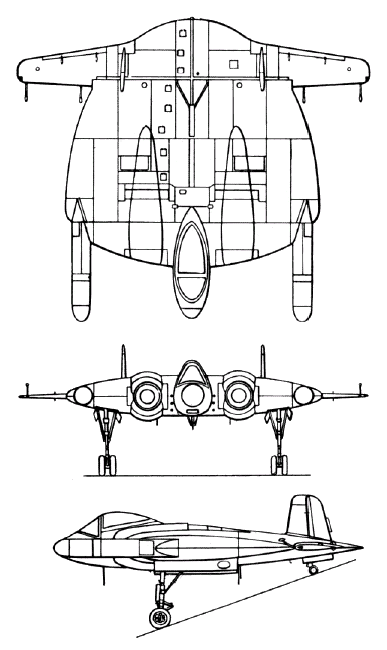New offerings from Canada, Eh.
[SIZE=3]De Havilland Canada CF-14 "Monarch"[/SIZE]
 Statistics
Statistics
-
Crew: 1
-
Length: 22.4 ft
-
Wingspan: 21 ft
-
Height: 12 ft
-
Wing area: 135 ft²
-
Empty weight: 4,750 lbs
-
Loaded weight: 6,500 lbs
-
Powerplant: Orenda Oneida II (1750hp)
-
Armament: 4x12.7mm MG (nose), 100 pound payload
-
Armour: 6mm Backplate for Pilot
Performance
-
Maximum speed: 435 mph @ 25,000 feet
-
Max Range: 750 mi
-
Service ceiling: 37,500 ft
-
Rate of Climb: 4,134 ft/min
Developed from work conducted by Miles Aircraft in Britain and Commonwealth Aircraft Corporation in Australia, through CADRE. Option packages include airship trapeeze rig and strenthened landing gear for carrier operations. Intended to replace the CF-8 "Archeopteryx" fighter for airship operations, and being evaluated for carrier duty.
[SIZE=3]Avro Canada CF-10 "Hammerhead"[/SIZE]
 Statistics
Statistics
-
Crew: 1
-
Length: 35.25 ft
-
Wingspan: 40 ft
-
Height: 12 ft
-
Wing area: 262 ft²
-
Empty weight: 10,310 lbs
-
Loaded weight: 14,000 lbs
-
Powerplant: Orenda Onondaga II (3000hp)
-
Armament: 4x20mm cannon (nose), 2,000 pound payload
-
Armour: 8mm Backplate for Pilot, self-sealing fuel tanks
Performance
-
Maximum speed: 462 mph
-
Max Range: 748 mi
-
Service ceiling: 33,650 ft
-
Rate of Climb: 2,618 ft/min
Advanced air superiority fighter design in development since 1939, based on principles and experience with the similar XCF-9 and CF-12 types.
[SIZE=3]Canadian Car & Foundry CF-15 "Frisbee"[/SIZE]
 Statistics
Statistics
-
Crew: 1
-
Length: 28.6 ft
-
Wingspan: 32.5 ft
-
Height: 14.75 ft
-
Wing area: 475 ft²
-
Empty weight: 13,107 lbs
-
Loaded weight: 16,722 lbs
-
Powerplant: 2xPratt & Whitney Canada R-2000-7 radial engine, (1,370hp)
-
Armament: 4x20mm cannon (nose), 2,000 pound payload
Performance
-
Maximum speed: 425 mph
-
Max Range: 1,064 mi
-
Service ceiling: 34,492 ft
-
Rate of Climb: 3,000 ft/min
Evolution of the "Zimmer-Skimmer" type, a much enlarged development of the CF-175 intended as a carrier fighter-bomber.
[SIZE=3]Canadian Vickers CB-18 "Sledgehammer"[/SIZE]
 Statistics
Statistics
-
Crew: 2
-
Length: 40 ft
-
Wingspan: 50 ft
-
Height: 15 ft
-
Wing area: 320 ft²
-
Empty weight: 9,871 lbs
-
Loaded weight: 15,500 lbs
-
Powerplant: Orenda Oneida II (1750hp)
-
Armament: 1x12.7mm MG (nose), 2x12.7mm MG (Dorsal turret), 2,500 pounds of bombs or Torpedo
-
Armour: 8mm Backplate for Pilot, self-sealing fuel tanks
Performance
-
Maximum speed: 295 mph
-
Max Range: 1,264 mi
-
Service ceiling: 25,500 ft
-
Rate of Climb: 1,578 ft/min
Carrier dive and torpedo bomber, developed through CADRE from the Supermarine Type 322 testbed, the CB-18 features a variable-incidence wing to increase flexability in carrier operations. Intended to replace CB-6 "Pterosaurs" in RCNAS service.




